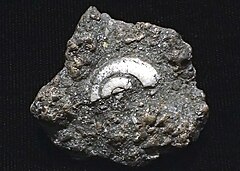| Leadville Limestone | |
|---|---|
| Stratigraphic range: Carboniferous | |
 Silver-replaced gastropod in fossiliferous limestone (Leadville Limestone; Aspen, Colorado) Silver-replaced gastropod in fossiliferous limestone (Leadville Limestone; Aspen, Colorado) | |
| Type | Formation |
| Sub-units | Castle Butte Member, Red Cliff Member, Yule Marble (informal) |
| Underlies | Molas Formation |
| Overlies | Chaffee Formation |
| Thickness | 220 feet (Marble Quadrangle, CO) |
| Location | |
| Region | Western U.S. |
| Country | United States |
| Extent | AZ, CO, NM, UT |
| Type section | |
| Named for | Leadville, Colorado |

The Leadville Limestone is a Mississippian geologic formation in the western United States. In Colorado, the upper part is oolitic limestone, while the lower part is primarily dolomite, and somewhat sandy beds indicate the bottom of the formation.
The formation is sparsely fossiliferous but contains many calcareous algae, Foraminifera (Endothyra), sponges, corals (Syringopora), Bryozoa, many brachiopods, gastropods (Bellerophon, Straparolus), Cephalopoda, fragments of ostracods, abundant fragments of crinoids, echinoid spines, and teeth of fish.
A metamorphic facies of this formation is known as the Yule Marble and has been quarried for construction materials.
See also
References
- Leadville, National Geologic Map Database, Geolex — Unit Summary. Last update: 6 August 2020
- Geologic map of the Marble quadrangle, Gunnison and Pitkin Counties, Colorado, Gaskill, D.L., and Godwin, L.H., 1966. USGS Geologic Quadrangle Map GQ-512. Map Scale: 1:24,000.
- Geology of Glenwood Springs Quadrangle and Vicinity, Northwestern Colorado, By N. Wood Bass and Stuart A. Northrop, 1963. GEOLOGICAL SURVEY BULLETIN 1142-J. pp. J26-J29.
This article about a specific stratigraphic formation in Colorado is a stub. You can help Misplaced Pages by expanding it. |
This article related to the Carboniferous period is a stub. You can help Misplaced Pages by expanding it. |